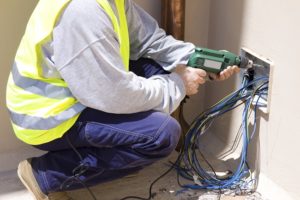
In structured cabling systems, there are two primary kinds of cables involved. Horizontal cabling and backbone cabling are different, but how so?
Networking often requires specific and complicated cabling. Within structured cabling systems, there are two main kinds of cabling that are utilized: backbone cabling and horizontal cabling. Neither is dispensable and both are necessary in developing a network that works for businesses or academic facilities alike. This may leave you wondering, however, what the difference between backbone cabling and horizontal cabling really is, so let’s break the specifics down below.
Backbone Cabling
Also sometimes called vertical cabling, backbone cables are used to provide interconnection between telecommunication rooms, entrance facilities, equipment rooms or buildings. As the name implies, these cables are used to develop a kind of “skeleton” for the network. The cables often run from floor to floor to provide connectivity. While backbone cabling can be done with many different kinds of cables including coaxial, fiber optic cabling is the most appropriate choice thanks to the higher bandwidth when compared to Cat5, Cat6, or Cat8 cables.
Horizontal Cabling
In contrast, horizontal cabling runs from a telecommunications equipment outlet to the telecommunications room or enclosure. This may be used to connect a variety of workstations and devices to information outlets, which then run to the telecommunications room. Depending on your needs, a typical gigabit Ethernet cable might do the job but fiber optic cables are preferable. Using fiber optic cables for backbone and Ethernet cable for horizonal cabling in many cases would analogous to using high-speed on-ramps to support narrow dirt highways.
Networking Matters
Backbone cabling and horizontal cabling cover different aspects of telecommunication services, but they’re both essential in large networks that may be seen in corporate settings or academic buildings. With that in mind, the specific kind of cables utilized can make a difference, so be sure you’re working with a networking professional.
Get in Touch with FiberPlus
FiberPlus has been providing data communication solutions for over 25 years in the Mid Atlantic Region for a number of different markets. What began as a cable installation company for Local Area Networks has grown into a leading provider of innovative technology solutions improving the way our customers communicate and keeping them secure. Our solutions now include:
- Structured Cabling (Fiberoptic, Copper and Coax for inside and outside plant networks)
- Electronic Security Systems (Access Control & CCTV Solutions)
- Wireless Access Point installations
- Public Safety DAS – Emergency Call Stations
- Audio/Video Services (Intercoms and Display Monitors)
- Support Services
- Specialty Systems
- Design/Build Services
FiberPlus promises the communities in which we serve that we will continue to expand and evolve as new technology is introduced within the telecommunications industry.
Have any questions? Interested in one of our services? Call FiberPlus today 800-394-3301, email us at info@fiberplusinc.com, or visit our contact page. Our offices are located in the Washington, DC metro area, Richmond, VA, and Columbus, OH. In Pennsylvania, please call Pennsylvania Networks, Inc. at 814-259-3999.
Do you enjoy clicking “Like” and “Follow?” Be sure to click on our official Pinterest, Facebook, Twitter, and LinkedIn pages today!